Effects of Forefoot Shoe on Knee and Ankle Loading during Running in Male Recreational Runners
Jingying Lu,Datao Xu,Wenjing Quan,2,Julien S.Baker and Yaodong Gu,★
1Faculty of Sports Science,Ningbo University,Ningbo,315211,China
2Faculty of Engineering,University of Pannonia,Veszprém,H-8201,Hungary
3Department of Sport and Physical Education,Hong Kong Baptist University,Hong Kong,999077,China
ABSTRACT Objectives:Although overuse running injury risks for the ankle and knee are high,the effect of different shoe designs on Achilles tendon force(ATF)and Patellofemoral joint contact force(PTF)loading rates are unclear.Therefore,the primary objective of this study was to compare the ATF at the ankle and the PTF and Patellofemoral joint stress force(PP)at the knee using different running shoe designs(forefoot shoes vs.normal shoes).Methods:Fourteen healthy recreational male runners were recruited to run over a force plate under two shoe conditions(forefoot shoes vs.normal shoes).Sagittal plane ankle and knee kinematics and ground reaction forces were simultaneously recorded.Ankle joint mechanics(ankle joint angle,velocity,moment and power)and the ATF were calculated.Knee joint mechanics(knee joint angle velocity,moment and power)and the PTF and PP were also calculated.Results:No significant differences were observed in the PTF,ankle plantarflexion angle,ankle dorsiflexion power,peak vertical active force,contact time and PTF between the two shoe conditions.Compared to wearing normal shoes,wearing the forefoot shoes demonstrated that the ankle dorsiflexion angle,knee flexion velocity,ankle dorsiflexion moment extension,knee extension moment,knee extension power,knee flexion power and the peak patellofemoral contact stress were significantly reduced.However,the ankle dorsiflexion velocity,ankle plantarflexion velocity,ankle plantarflexion moment and Achilles tendons force increased significantly.Conclusions:These findings suggest that wearing forefoot shoes significantly decreases the patellofemoral joint stress by reducing the moment of knee extension,however the shoes increased the ankle plantarflexion moment and ATF force.The forefoot shoes effectively reduced the load on the patellofemoral joint during the stance phase of running.However,it is not recommended for new and novice runners and patients with Achilles tendon injuries to wear forefoot shoes.
KEYWORDS Patellofemoral contact force;patellofemoral contact stress;footwear;achilles tendons force
1 Introduction
In recent years,the number of marathon events and the number of marathon participants have continued to increase[1].Nevertheless,running-related injuries have been identified as common overuse injuries among competitive runners and recreational runners.Indeed,the risk of running-related injuries has increased from 6.9% to 92.4% per 1000 h of running[2,3].Most running-related injuries are microtrauma injuries caused by the chronic submaximal loading of tendons,muscles or bones[3].It has been observed that long-distance running injuries are associated with high impact force.Lower limb injuries have always been a problem for runners regardless of footwear.Despite significant advances in shoe technology over the past 50 years,the rate of sustaining a running-related injury has remained relatively stable.Although in the past 50 years,running shoe technology has made tremendous progress,the injury rate associated with running is still relatively stable[4-6].
Many factors can cause running over-using injuries,such as poor training methods,different running shoes,and running distance[7,8].It has been shown that the ankle joint and knee joint are the most common areas associated with running injuries.The types of injuries observed include patellofemoral joint pain,strains of the tibia,Achilles tendon,gastrocnemius,foot and thigh muscles[9,10].
The Achilles tendon,which is a crucial structure connects the heel and flexor plantaris.The Achilles tendon’s function can transmit the gastrocnemius and soleus muscles’contraction force during movement[11].It is a critical part of the lower limb to effectively store and release force and energy during running and jumping[12].Evidence suggests that Achilles tendinopathy is the most common running injury,and the incidence of injury for Achilles tendinopathy increased 8%-15% for long-distance runners[13].Achilles tendon injuries have been reported extensively in previous running studies.Almon Roeder et al.reported that Achilles tendon injury might result from the high respective loading rate and high tendon forces during running[14,15].Lorimer et al.found that essential factors might be associated with the risk of Achilles tendon injuries,such as high braking force,high vertical forces,high arch and high propulsive forces[16].
In recent years,most studies have focused on the foot strike pattern.During human evolution,the barefoot was regarded as a natural foot strike pattern[17].A previous study found that more than 75% of people were rearfoot strikers during marathon competitions[18].A survey of professional long-distance runners and amateur runners showed that 69%-95.1% of runners were rearfoot strikes.Only 4.9%-31%of runners used a forefoot or midfoot strike pattern,indicating that most people are more accustomed to using the rearfoot to record strike patterns[19,20].Many runners currently transform the strike pattern into a forefoot strike pattern to reduce the risk of injuries and improve running performance.Compared with barefoot and rearfoot running strike patterns,barefoot patterns decrease stance times,stride lengths,knee moment,power,and increase the ankle plantarflexion angle and moment[21,22].Compared with barefoot running,healthy adults accustomed to running with shoes,have rotational joint moment of the hip and knee joint increases of 54% and 38% and knee flexion moments increase by 36%.The larger knee joint flexion moment might cause chronic injuries such as knee arthritis and patellofemoral joint pain[21,23].Thus,many shoe manufacturers have also begun to focus on barefoot running,in which Vibram Five Fingers,Nike Free and minimalist shod were produced and incorporated into the forefoot style[24,25].It has been reported that forefoot runners exhibit increases in Achilles tendon force(ATF)and reductions in patellofemoral contact force(PTF)and pressure(PP)in comparison to individuals exhibiting a rearfoot strike pattern[26].Numerous studies have verified that BF and minimalist BFIS were associated with increases in vertical loading rates,reduced knee extensor and increased ankle plantarflexion moments[24,27].Therefore,barefoot and minimalist shod improved performance and prevented the risk of impact injury.
Previous studies have suggested that running style can be successfully retrained in a comparatively short time period with proper training.More and more people will choose some appropriate way to change the strike pattern[28,29].A new training method by using forefoot shoes can change the foot strike pattern,which is the pose running method[30].Not only was the footwear focused on the strike pattern,but also the training method was considered into the forefoot strike pattern[31,32].A variety of running shoes have been developed to adapt to different types of runners,different running styles,and different running conditions.Footwear manufacturers have altered the essential elements of the running shoe model to adjust these differences,including midsole cushioning and heel-toe drop[5,33].Until the past few years,conventional running shoes always had a heel-toe drop;the difference between the heel height and the midsole forefoot height was greater than 10 mm.The minimalist shoe,characterized by little cushioning and heel drop,became popular among runners in 2009.The reason for the minimalist shoe’s popularity is large because of the benefits supported by shoe manufacturers and researchers,who state that lack of cushioning can reduce running-related injuries by supporting a more natural forefoot strike pattern[5,18].However,the popularity of the minimalist shoe has been declined in recent years,primarily because studies have shown that the use of forefoot strike mode does not reduce the risk of injury or improve the running economy[32].Heel-toe drop refers to the difference between the height of the heel and the height of the forefoot.The initial difference between the heel and the forefoot is about 12 mm,or even 15-19 mm higher.We designed a new running shoe to decrease the heel-toe drop,called the forefoot running shoe.The heel of the forefoot running shoe is lower than the toe,which can passively change the rearfoot strike into a forefoot strike pattern quickly.The previous literature has rarely explored the influence of this unique heel-toe drop design on running biomechanics.
Much research has been conducted on different strike patterns during running and how they can affect Achilles tendon biomechanics associated with running-related Achilles tendon injury[34,35].Several studies have shown that Achilles tendon force during running can be calculated by dividing net ankle joint moments and Achilles tendon moments arm using the inverse dynamics approach.A previous study has confirmed that runners who are rearfoot strikers had less peak AT stress,strain,and strain rate compared with forefoot strike patterns[34].Furthermore,previous studies demonstrated that foot strike patterns were not related to Achilles tendon cross-sectional area and stiffness in highly trained longdistance runners[36].Zhang et al.examined rearfoot strike runners and Achilles tendon force in minimalist and conventional running shoes.It was demonstrated that wearing conventional shoes with rearfoot strike patterns showed increased Achilles tendon force,loading rate,and stress compared with minimalist shoes[37].Similarly,Sinclair found that running with barefoot and barefoot inspired footwear may significantly increase Achilles tendon force and reduce patellofemoral kinetic parameters compared to conventional shoes.Therefore,Achilles tendon force should be explored when running in minimalist and conventional shoes,which may underestimate AT mechanics when changing the foot strike.
Therefore,the primary objective of this study was to compare the Achilles tendon force at the ankle and the Patellofemoral joint contact force(PTF)and Patellofemoral joint stress force(PP)at the knee using different running shoe conditions(forefoot shoevs.normal shoe).We hypothesized that the peak Achilles tendon force,loading rate and Patellofemoral joint stress force would be lower among runners who run using a rear-foot strike in normal shoes than those who run with a forefoot strike in minimalist shoes.
2 Materials and Methods
2.1 Participants
Fourteen recreational male runners with 3 times a week running experience(height:174.3±3.2 cm;age:25.8±1.9 years;body weight:63.2±4.5 kg)recruited from local running clubs participated in the study.Research on lower extremity biomechanics comparing conditions has shown that a minimum of 11 individuals is needed for comparison to attain an alpha level of 0.05,according to a power analysis.Each had a minimum of 10 km weekly running volume.Only runners with shoe size 9±0.5(US size)and right leg dominant(defined as the preferred lower limb when kicking a ball)were included[38].The experimental protocol was approved by the Institutional Review Board and all runners signed written informed consent prior to experimental data collection.
2.2 Shoe Condition
Two pairs of running shoes(41 EUR)were used in this study.The most important difference between the two different condition running shoes is the heel-toe drop(Fig.1),the offset of normal shoes is 7 mm,while the offset of forefoot shoes is-8 mm.The offset was defined as rearfoot height minus forefoot height.The sole materials of both normal shoes and forefoot shoes were made of ethylene vinyl acetate(EVA)foams.And the shoe upper material of both normal shoes and forefoot shoes were made of nylon(polyamide)polyvinyl chloride(PVC).More details about the shoes are presented in Table 1.

Figure 1:Forefoot shoe(A)and Normal shoe(B)Used in the experiment
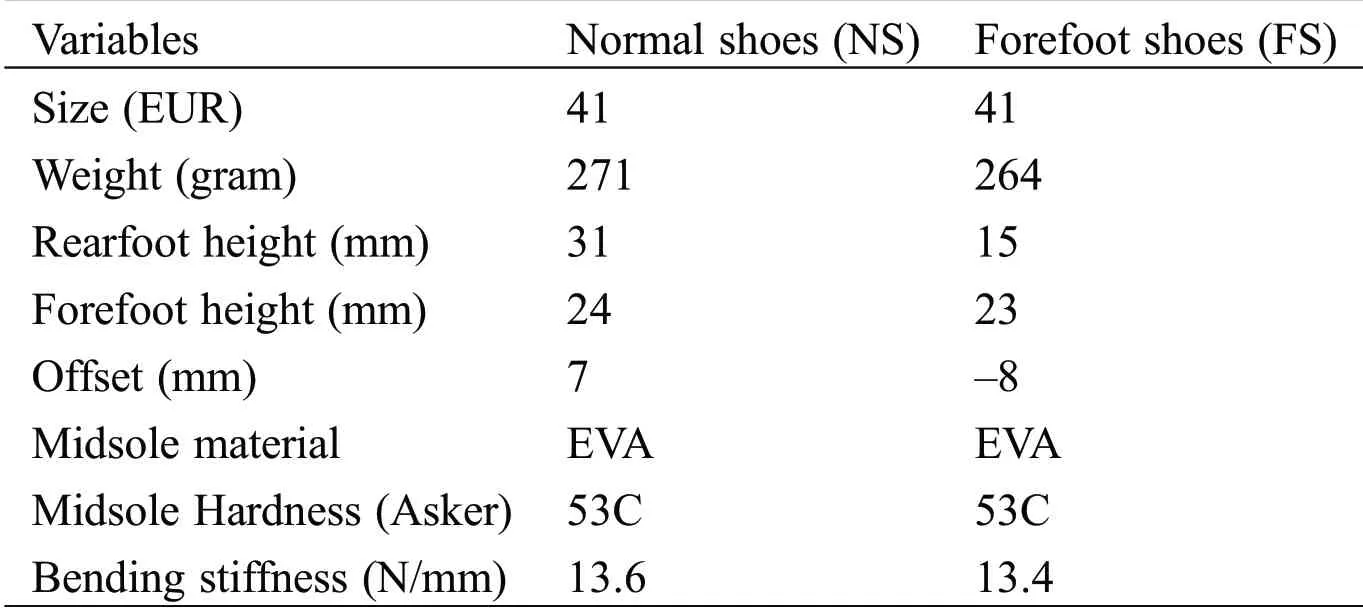
Table 1:Detailed comparison of the two running shoes.
2.3 Procedure
Running kinematic data was collected with an eight-camera motion capture system(Vicon Metrics,Ltd.,version 1.8.5,Oxford,UK)at a sampling frequency of 200 Hz.36 retroreflective markers were placed on the lower limb of each participant to track movement[39].Running kinetic data was collected with a force plate(AMTI,Watertown,MA,USA)which was placed in the middle of an over ground runway with a sampling frequency of 1000 Hz.The 6DOF model(double leg)was used to collect biomechanical parameter changes.The marker locations included:right and left anterior superior iliac spine,left and right posterior superior iliac spine,medial and lateral condyle,medial and lateral malleolus,first and fifth metatarsal heads,distal interphalangeal joint of the second toe.Tracking clusters were placed on the middle and lateral thigh,shank and right heel.
Runners were wearing tight pants and T-shirts during data collection.The data was collected as participants ran on the 15 m long over ground runway at a speed of 3.3 m/s,participants ran under two different shoe conditions(forefoot shoe,normal shoe)in a random order.Participants’running speed was measured with infrared timers.The infrared timers were placed on either side of the 15 m track to measure the participants’running speed(specific location:4-meter behind/in front of the force plate).The experimental procedures were the same for both shoes.A trial was successful when the runners ran at the fixed speed and maintained their running strike pattern before landing on the force plate completely with the right foot.Each participant finished 5 successful running trials in both the forefoot shoe condition and normal foot condition.Before testing,runners had 10 min to warm up and familiarize themselves with equipment and procedures.
2.4 Data Analysis
Kinematic and kinetic variables of the running stance phase were processed and quantified using Visual 3D(C-Motion,Germantown,MD,USA)by extract C3D files from Vicon system.The reflective markers were filtered using a 14 Hz low pass Butterworth filter and the ground reaction force(GRF)filtered using a 50 Hz fourth-order Butterworth filter[40,41].The stance phase was defined as the period of initial contact to toe-off of from the ground.The Cardan angle expressed by the distal segment relative to the proximal segment was used to calculate the sagittal angle of the knee and ankle joints.Joint kinetic parameters were calculated using an inverse dynamic approach.The ground reaction force parameters and net joint moments were normalized to the body weight(BW)of each participant.The GRFs of interest were the peak force,vertical average loading rate(VALR)and contact time.VALR of the forefoot shoe was the average slope calculated from the initial foot contact to the peak force,while the VALR of the normal shoe was the average slope computed from the initial foot contact to the first peak force[42].
Achilles tendons force(ATF)was calculated by dividing ankle plantarflexion moment(Ma)by the estimated Achilles tendon lever arm(La).The moment arm was estimated as an estimation equation by the sagittal plane ankle angle(a),using the procedure described by Self et al.[43].

Patellofemoral joint contact force(PTF)during running was estimated as a function of the knee flexion angle(x)and extensor moment(Mk)according to the procedure described by Ho et al.[44].First,the arm of the quadriceps muscle(Lq)was computed using the sagittal knee flexion angle using the non-linear equation[36].

Then compute the quadriceps force(Fq)using the below formula:

Finally,PTF was computed using the quadriceps force(Fq)and a constant(k):

The constant k was calculated for knee joint angle position(x)using the non-linear equation described by van Eijden et al.[45].

Other details can also be referred to Fekete et al.[46].Patellofemoral joint stress force(PP)was then calculated as the PTF divided by the patellofemoral contact area.The contact area was calculated according to Ho et al.[44].The contact area of the patellofemoral(mm2)is a function of the sagittal knee angle(x)[47].

2.5 Statistical Analysis
An independent-samplest-test was used examine any shoe differences.Before statistical analysis,all experimental data were statistically analyzed using the normality Shapiro Wilks test.Significance levels were set atp<0.05.The statistical calculations were completed using SPSS statistical software(23.0,SPSS Inc.,Chicago,IL,USA).
Data were time-normalized to the stance phase for statistical parametric mapping of one dimension(SPM1D)(101 data points per stance phase)[48].Biomechanical differences between the forefoot shoe and normal shoe were analyzed by examining the entire time series using SPMID using an independentsamplest-test.The statistical analyses of the SPM1D were finalized in MATLAB version 2019b(MathWorks Inc.,Natick,MA,USA),and the significance level was set atp<0.05.
3 Results
3.1 SPM Results
Fig.2 outlines the significant differences for joint angle,velocity,moment,and power of ankle and knee in the sagittal plane during the running stance phase between the forefoot shoe and normal shoe.Significant differences between shoes were found for all joint kinematic and kinetic variables in both the ankle and knee.Fig.3 shows the significant differences for vertical GRFs between the forefoot shoe and normal shoe,significantly different values between shoes werep=0.003,p=0.004,p=0.026,p=0.037.
The data demonstrate significant differences for the joint kinematics of the ankle and knee in the sagittal plane during the running stance phase between the forefoot shoe and normal shoe.Ankle angle:(0~14.89%,p=0.045)(36.67~90.01%,p=0.011);Ankle velocity:(0~21.79%,p<0.001)(22.79~61.52%,p<0.001)(67.41~90.26%,p<0.001)(95.28~100%,p=0.038);Knee angle:(0~20.42%,p=0.041);Knee velocity:(0~9.58%,p=0.024)(11.48~37.51%,p<0.001)(44.23~68.49%,p<0.001)(76.38~100%,p=0.001).
The data also show significant differences for joint dynamics of the ankle and knee in the sagittal plane during the running stance phase between the forefoot shoe and normal shoe.Ankle moment:(0~58.29%,p<0.001)(86.74~100%,p=0.005);Ankle power:(0~33.98%,p<0.001)(36.02~61.81%,p<0.001)(94.69~100%,p=0.016);Knee moment(0~1.97%,p=0.048)(9.70~58.18%,p<0.001)(91.35~100%,p=0.019);Knee power:(2.93~7.78%,p=0.016)(10.23~38.23%,p<0.001)(42.53~64.43,p<0.001)(94.26~100%,p=0.010).
There were significant differences for ATF during the running stance phase between the forefoot shoe and normal shoe as shown in Fig.4A.ATF:(0~65.33%,p<0.001)(82.65~100%,p=0.003).PTF showed significant differences for PTF during the running stance phase between the forefoot shoe and normal shoe in Fig.4B.PTF:(0~3.57%,p=0.044)(14.89~26.58%,p=0.011)(89.62~100%,p=0.015).PP showed significant differences for Pp during the running stance phase between the forefoot shoe and normal shoe in Fig.4C.PP:(0~3.74%,p=0.043)(13.02~43.42%,p<0.001)(90.64~100%,p=0.019)
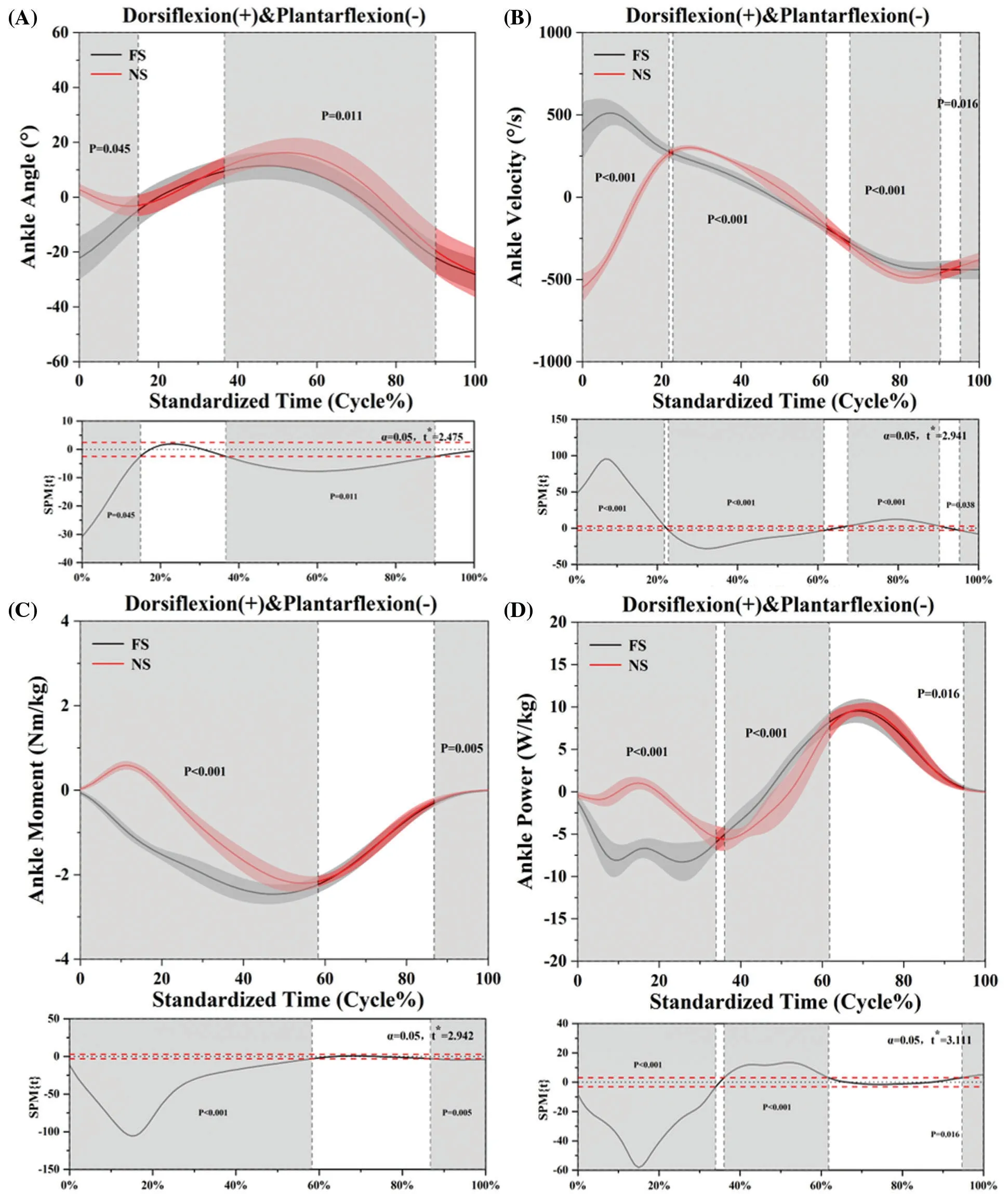
Figure 2:(Continued)
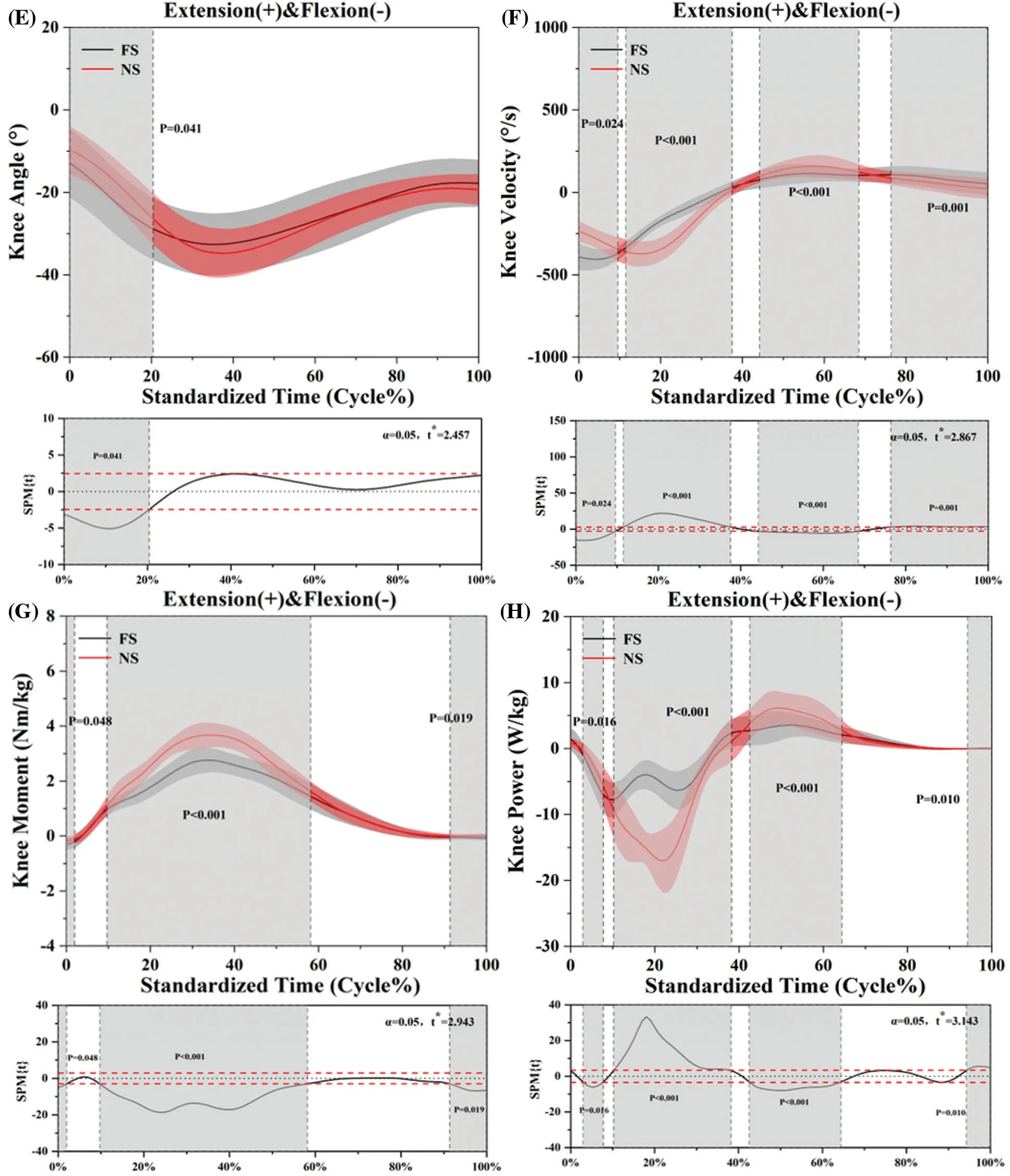
Figure 2:The means and standard deviations for ankle angles,ankle velocity,ankle moment and ankle power in A to D,and E to H were the knee angle,knee velocity,knee power and knee moment between forefoot shoe and normal shoe.Dashed red lines represent p=0.05 level
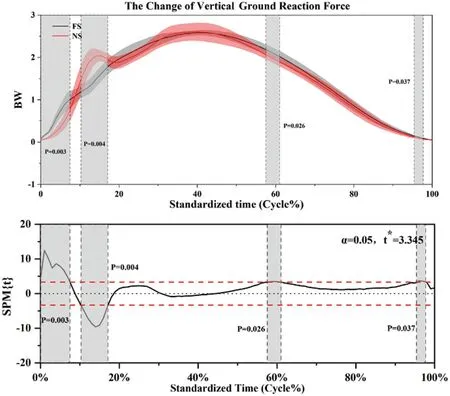
Figure 3:Ground reaction forces during the running stance phase between the forefoot shoe and normal shoe.Dashed red lines represent p=0.05 level
3.2 Traditional Analysis Results
Table 2 shows that the ankle dorsiflexion angle(p<0.001),knee flexion angle(p=0.031),ankle dorsiflexion velocity(p<0.001),ankle plantarflexion velocity(p<0.001)and knee flexion velocity(p=0.001)were significantly different between the forefoot shoe and normal shoes during the running stance phase.Table 3 shows the significant differences in joint kinetics between the forefoot shoe and normal shoe for ankle dorsiflexion moment(p<0.001),ankle plantarflexion moment(p<0.001),knee extension moment(p<0.001),knee flexion moment(p<0.001),ankle plantarflexion power(p<0.001),knee extension power(p<0.001)and knee flexion power(p<0.001).Table 4 shows that VALR(p<0.001)was significantly different between shoes.Patellofemoral joint contact force using normal shoes was significantly greater when compared to forefoot shoes at the knee level.Moreover,the achilleas tendon forces(p<0.001)were significantly lower than the forefoot shoes(Table 2).

Table 2:Sagittal plane kinematics during running stance phase under two different shoe conditions(mean±SD)
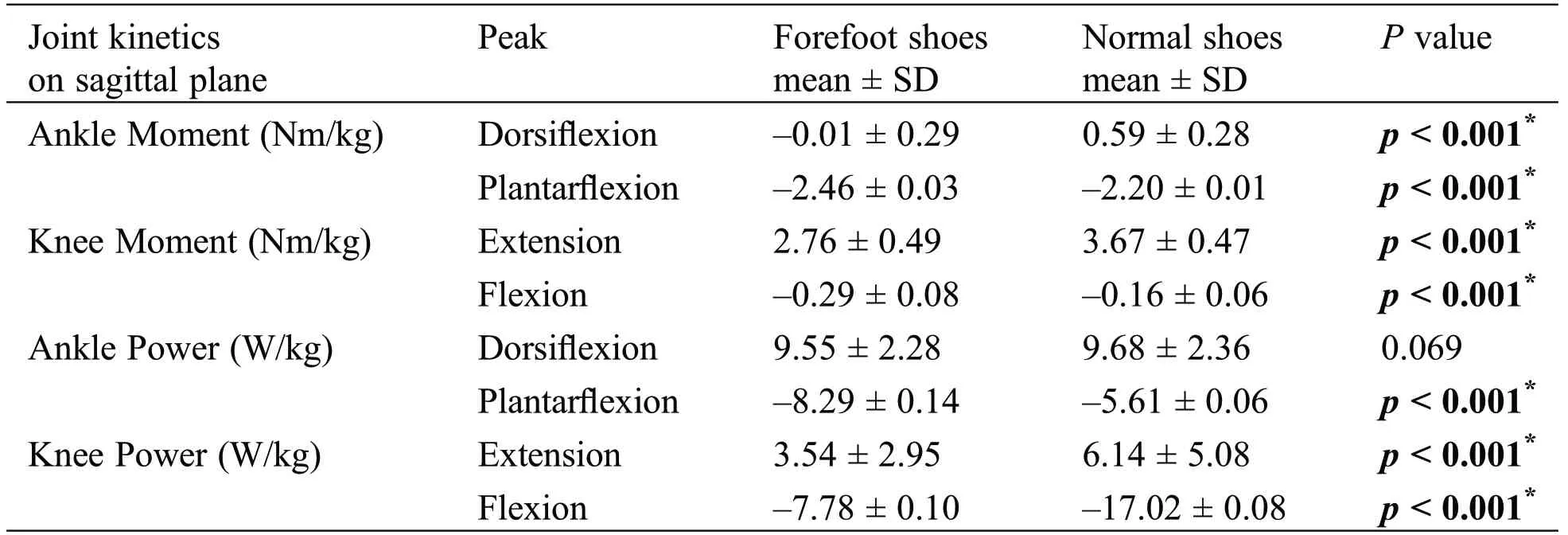
Table 3:Sagittal plane kinetics during running stance phase with two different shoe conditions(mean±SD)

Table 4:Ground reaction force during running stance phase with two different shoe conditions(mean±SD)
4 Discussion
This study aimed to determine whether habitually rearfoot strike runners would immediately adopt different running strikes when wearing forefoot shoes and normal shoes.The study explored the immediate different shoes’effect on the patellofemoral joint stress force,Achilleas tendon force,and patellofemoral joint contact force.The present study primary results were that there were no significant differences observed in the PTF,ankle plantarflexion angle,ankle dorsiflexion power,peak vertical active force,contact time and patellofemoral joint contact force between the two shoe conditions.Compared to wearing the normal shoes,wearing the forefoot shoes showed that the ankle dorsiflexion angle,knee flexion velocity,ankle dorsiflexion moment extension,knee extension moment,knee extension power,knee flexion power and the peak patellofemoral contact stress were significantly reduced.However,the ankle dorsiflexion velocity,ankle plantarflexion velocity,ankle plantarflexion moment and Achilles tendon force increased significantly.These results in joint power were kept in line with Williams et al.[49]that running with forefoot shoes could lead to a significantly higher plantarflexion power in the ankle and lower negative power in knee.And that mainly because forefoot shoes contribute a shift of the absorption mechanism of loading from knee to ankle and more depends on ankle to absorption rather than knee.
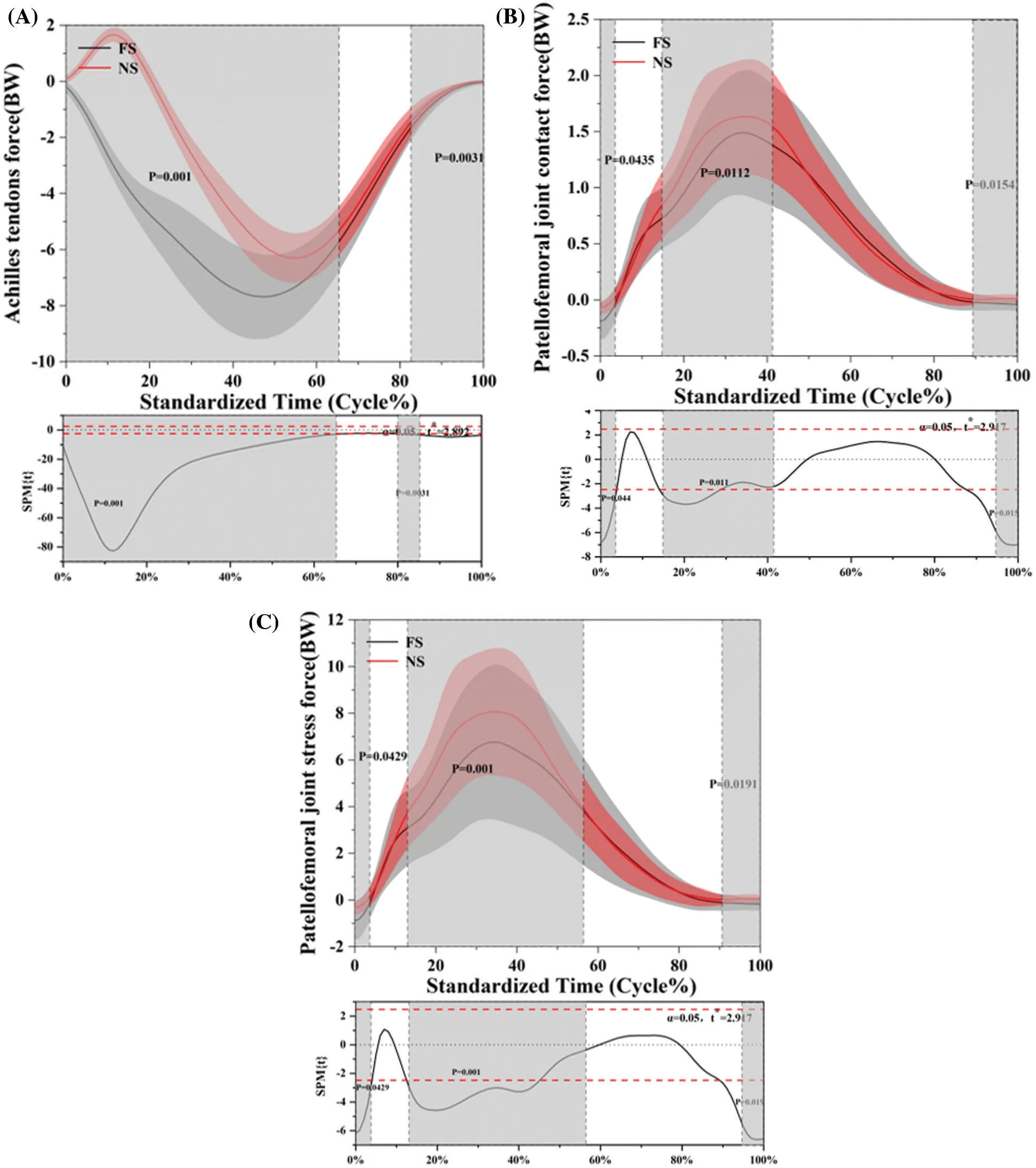
Figure 4:Comparing the mean values of ankle and knee kinetics from all participants between shoe conditions(forefoot shoes vs.normal shoes).(A)Achilles tendons force(ATF);(B)Patellofemoral joint contact force(PTF);(C)Patellofemoral joint contact force(PP).Dashed red lines represent p=0.05 level
In support of our hypothesis,the Achilleas tendons force and patellofemoral joint stress force were different between the normal shoes and forefoot shoes.However,there were no differences between the patellofemoral joint contact force for the two different running shoes.Epidemiological studies on running injuries have found that the knee joint is the most common injury site,while patellar softening and patellar surface pain are the most common knee joint injuries[9].Kulmala et al.have found that the full foot or forefoot strike pattern is accompanied by a decrease in pressure and pressure of the patellofemoral joint results in an increase in tension of the Achilles tendon[50].Our finding is consistent with Sinclair et al.,who reported that wearing minimalist shoes can significantly reduce patellofemoral joint stress force and increase Achilles tendon force[20].In the present study,the result showed that the knee extension moment was reduced when subjects wore forefoot shoes.A decrease in knee extension moment will inevitably lead to weakened quadriceps muscle activity and reduced patellofemoral joint load.The reduction in the knee joint moment is beneficial in the prevention and rehabilitation of knee joint injuries.A small knee flexion angle reduces the moment arm of the knee extension moment,thereby reducing patellofemoral joint pressure.
This study demonstrated a greater Achilles tendon force and ankle plantarflexion moment in forefoot shoe runners than normal shoe runners.Our result indicated that participants wearing forefoot shoes can change the rearfoot strike pattern into a forefoot strike pattern.Meanwhile,the results support runners who wear forefoot shoes which tend to have a forefoot strike pattern[17].The forefoot strike pattern requires the triceps surae muscle to reduce ankle dorsiflexion,which might cause a high load on the Achilles tendon and a larger ankle plantarflexion moment[21,50-52].This study observed that the forefoot shoes without the heel damping material cushion,that the ground impact is more directly transmitted to the proximal end to the ankle joint,and the force on the Achilles tendon was increased.Simultaneously,as the thickness of the heel’s midsole decreases,the landing pattern changes to the forefoot strike pattern.The heel cannot fully contact the ground,and the distal end of the Achilles tendon is passively pulled downward,resulting in increased tension of the Achilles tendon.
This study identified a higher vertical average loading rate when participants were wearing forefoot shoes.This may be because running shoes do not have a heel damping structure to play a damping role during running performance,the cushioning capacity of the sole is weakened,and the cushioning time is reduced,which increases the loading rate.The study of Chambon et al.also reported a similar conclusion:as the heel gap decreases,the loading rate of the ground impact force increases significantly,and under barefoot conditions is higher[53].It has been noted previously that higher peak propulsive force may increase the risk of Achilles tendon injuries[15,54].
In conclusion,the foot-strike pattern is a potentially modifiable aspect of running performance that may increase Achilles tendon injury risk.The habitually rearfoot strike runners wearing forefoot shoes can instantly change the rearfoot strike pattern into a forefoot strike,reducing ground reaction force,knee joint load and energy consumption.Simultaneously,it can improve athletic performance and prevent injuries.The forefoot shoe can also be used to treat patients with knee joint injuries and dysfunction.It is not recommended for new runners and patients with Achilles tendon injuries to wear this running shoe.
Several limitations should be considered.This study focuses only on the ATF,PTF and PP mechanical properties in habitually rearfoot strike runners.A group of runners who are used to forefoot strike with forefoot shoes could be added to compare habitual rearfoot strike runners wearing normal shoes.The participants recruited in this study were recreational runners.In the future,we should consider different levels of running ability and gender differences.Finally,collecting muscle modeling data can be used to better calculate joint force.
Funding Statement:This study was sponsored by the NSFC-RSE Joint Project(81911530253),Key R&D Program of Zhejiang Province China(2021C03130),Public Welfare Science and Technology Project of Ningbo,China(2021S133),Zhejiang Province Science Fund for Distinguished Young Scholars(R22A021199)and K.C.Wong Magna Fund in Ningbo University.
Conflicts of Interest:The authors declare that they have no conflicts of interest to report regarding the present study.
 Molecular&Cellular Biomechanics2022年2期
Molecular&Cellular Biomechanics2022年2期
- Molecular&Cellular Biomechanics的其它文章
- Numerical Analysis of Blood Flow through COVID-19 Infected Arteries
- Influence of Nutritional Supplementation and Sports Training on the Physical Fitness of Track and Field Athletes
- Injectable Collagen/CMC Soft Tissue Filler with Developed Flow Properties
- A Study on the Effect of Core Strength Strengthening Training on Exercise-Induced Lumbar Injuries
